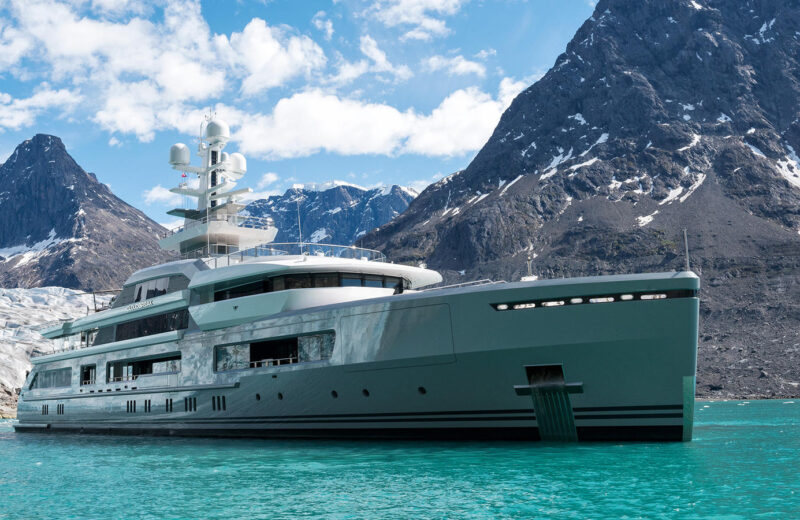A View From The Bridge: Explorer Yachts

Iain Flockhart is a highly experienced superyacht captain with over 250,000 Nm in the role of professional captain since 1996.
Many vessels these days are called “explorer” or “expedition” yachts. But do they all measure up to our perceptions of how such a vessel should be?
Not always.
A 65m-plus yacht I was once involved in was billed by its owner/builder as being an expedition yacht.
However, it had not a single feature that I would consider contributed meaningfully towards her being categorised in this way when compared to other yachts of her size.
Despite many proposals that would have made her far more akin to a true expedition yacht, none were adopted.
A common failing of owners in the design stage is minimal consideration of the operational aspects of running a ship.
Let’s be honest, regardless of the owner’s wishes for space, design, style and/or completely unique features, if the operational side of things has been inadequately considered — as can frequently be the case – it will be a struggle to achieve the owner’s full expectations of the vessel and its crew.
If you want to go on proper yachting expeditions and explore, then you should be looking to build a vessel that is specifically designed to do so at every level.
Do not just build or buy a yacht that looks the part.
Here is a basic list of areas that should be more closely examined by any owner wishing to build or buy such a vessel:
Self-sufficiency should always be high on the agenda so that you are more confident when going farther afield with reduced need to worry about external support.
- Intact and damage stability.
- Quality of naval architecture, and overall engineering.
- Extended range and endurance.
- Larger tanks of all varieties onboard: fuel, water, clean and dirty oils, bilge water, other waste liquids.
- Easy access to all equipment for easy maintenance.
- Think very carefully about redundancy, especially all mission-critical equipment, bridge navigation and coms, propulsion, power generation, emergency power, fuel scrubbing, HVAC, pumps, sanitation, additional LSAs, etc.
You may need to build in additional tech spaces/machinery rooms to accommodate your additional systems. And you’d better plan for lots of additional dedicated space for spares and additional equipment. Consider additional space for general storage of equipment and operational tasks. Parkinson’s Law applies to available space too.
Fatigue is a major issue on yachts. One way to combat it is through the provision of additional crew cabins. It is easy enough to build two additional crew cabins in a vessel over 60m that will give you space for four additional crew members for when you need them on extended trips.
And then add at least one additional cabin for pilots, maritime or aviators, contractors, guides, additional personal staff. More crew and the space to put them in equates to safer manning and better service.
Then a yacht’s complement, like an army, marches on its stomach. Victualing for long trips needs special consideration from the design stage such as additional fridges, freezers, dry stores, etc. Proper garbage processing, compacting and long-term storage needs to be designed from scratch. If you are going to tropical areas then refrigeration of the rubbish storage area should be considered.
A dedicated medical space might be prudent, including a quarantine area for containment, and a dual role medical professional onboard that could also fill a more day-to-day role onboard.
Dynamic positioning is a serious consideration so the vessel can remain in place without fear of anchors damaging the ecosystem or if anchors can’t be used if they are prohibited or if water depths are untenable. Also, consider additional ground tackle for deep/steep shelving water if you do not have DP or in emergency situations.
Extensive tools and some lifting equipment should be planned for along with a well-equipped and spacious workshop with a lathe and mill so that spares can be made from stock materials if necessary.
Sat coms failure could be disastrous on an expedition, provision of a full back up, installed at build, could be a great investment.
Recording your adventures to be enjoyed over and again is commonplace now. You might want to include a small editing suite. It only requires a minimal space with a dedicated computer and a crew member adept in editing skills but can preserve your memories beautifully, forever.
Will you be undertaking any research on your adventures? Environmental, ecological, archaeological etc.? Include a laboratory into your design, to facilitate such work and keep to it properly separated and SAFE from the other operational or guest spaces. A decompression chamber if serious diving takes place.
Tenders should be suitably sized, fit for purpose, and be sufficient in number to meet requirements.
Proper life boats customised for a better probability of survival. They come at a cost in space, aesthetics and financial, but worth it. The safer we feel we are, the more intrepid we tend to be.
Do not underestimate the thought required to build a successful expedition vessel, so look to the commercial world for inspiration. When the vessel is built, off you go across the blue.

Iain is a highly experienced yacht captain with over 250,000 Nm in the role of professional captain since 1996. He grew up on sailing vessels but chooses to work on motor yachts now. He has a great reputation for crew loyalty and retention, through solid management, mentoring and leadership. Iain has a wealth of experience of working in very challenging roles. He has a wide and varied skill set with solid management and administrative skills.
Iain enjoys simple pleasures such as using his 7m RIB to go exploring and wild camping in his native Scotland.
Iain is currently looking for new opportunities to command a superyacht.

